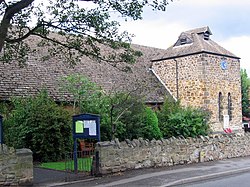Stonebroom
| Stonebroom | |
| Derbyshire | |
|---|---|
 St Peter's Church, Stonebroom | |
| Location | |
| Grid reference: | SK415597 |
| Location: | 53°7’58"N, 1°22’44"W |
| Data | |
| Post town: | Alfreton |
| Postcode: | DE55 |
| Dialling code: | 01773 |
| Local Government | |
| Council: | North East Derbyshire |
| Parliamentary constituency: |
North East Derbyshire |
Stonebroom is a village in Derbyshire, to the east of the A61 between Alfreton and Clay Cross. It has a primary, nursery, pre-school and two churches, one Church of England and one Methodist.
The parish church, St Peter's Church, was built in 1900. It is today part of a Benefice with the Church of England churches in Shirland and Morton.
History
Five households are listed for Stonebroom in the 1841 Census (Shirland Parish) with a sixth listed separately under Pasture House which is part of the village. A directory from 1846 does not mention Stonebroom but one from 1857 acknowledges it and only gives the names of four farmer resident there. A directory from 1895 describes it as 'a considerable village - it is a typical colliery village, and has sprung into existence in recent years'.
In the mid-19th century, houses were built for colliery workers and were called 'the blocks'. These were blocks of eight terraced houses with 160 dwellings. They were condemned before 1939 but still there in 1947 and described by the Derbyshire Times as "The Black Hole of Derbyshire". In 1950 they were demolished but the area of wasteland was known as The Blocks by the locals. From the 1970s new housing and industrial estates were built on the land. Meanwhile, a massive housing estate had already been established in the "upper" area of Stonebroom.
The village is linear and was formed from two hamlets, early maps show them as Upper Stone and Lower Stone. The School playing field was once the site of a quarry, this is still called Quarry Lane. It is probable that the name Stonebroom was derived from this quarry which provided stone, it is said that the field behind the quarry was full of broom, which gave one possible explanation for the unusual village name. Another report states that the Roman 'Stan Brom' means quarry.
Outside links
| ("Wikimedia Commons" has material about Stonebroom) |
